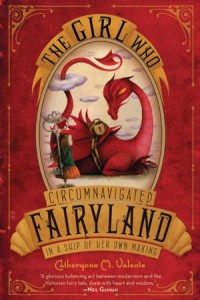 Review written by Jonathan Lavallee
Review written by Jonathan Lavallee
The Girl Who Circumnavigated Fairyland in a Ship of Her Own Making is about a girl named September who is unhappy with the way things are going in her life. Her father is off fighting in the war and her mother spends too much time working at the factory. She meets the Green Wind and goes on an adventure through Fairyland, and she finds that things are not as wonderful and magical as she would have thought. The Marquess has taken away a lot of things, and many of the faeries are either barred from entry or they’re shunted off to the winterlands. September ends up travelling around looking for what was lost, for witches, for new found friends, and even for the Marquess.
The Girl who Circumnavigated Fairyland feels a lot like you’ve stepped into a Lewis Carroll tale, mixed with a bit of C.S. Lewis (apparently the author has a thing for the Lewises). It works on its own logic a lot of the time—the kind of fairytale logic where giant wheeled vehicles migrate, and where no one questions the lists that people are on, or why everything that can fly is chained down, or why the toll to cross the river is paid in little children. Some of these elements may need to be explained to some younger kids or they might end up wondering what’s going on rather than being engaged in the story.
Overall I liked this book, although as a grown up you may have to get a couple of chapters in before you start enjoying the story. I know I felt that some of the chaos was a little forced at first, but when I read it to the girls they didn’t mind in the least and enjoyed it from the start. I probably could have too, if I locked the cynical part of my brain away. However, once the book starts rolling it dragged even my very cynical mind into the tale and I couldn’t wait to find out what was going to happen next.
SPOILER ALERT: Things you might want to know before suggesting this to your kid
Loss
There is loss all over the place—from something as simple as a shoe to September’s friends and allies. The loss is less people misplacing things, and more along the lines of objects and allies being taken. September loses her shadow, as well as her friends on multiple occasions. The witch has lost her foretelling spoon. Everyone feels the loss of Queen Mallow. Loss is everywhere you turn.
Death
Characters die, and often when they do it’s very quick and with little warning. September even has to confront her own death—literally, as her Death appears as a character in the confrontation—in order to find the mystical object that she seeks. When the Marquess is thwarted and defeated at the end of the book, she uses the magic she has left to put herself to sleep. The language used to describe this is very similar to the language we use to describe someone taking their own life. You can argue for either way, but the fact that this “death” is there is worth mentioning.
Violence
There’s definitely violence in this book. The Marquess is very overt with her threats of violence to loved ones. Part of what keeps a lot of the fairy creatures in check is the threat of the Marquess’ violence. There is a Marid—water djinn—named Saturday, and the only way to get a wish out of a Marid is to wrestle with it—yet wrestle is too mild a word for what happens. It’s a drawn out fist fight where September and Saturday crash through glass floors and throw punches in an attempt to make the other submit. There are water creatures that demand a toll in small children from passing boats. September’s hunger leads to what is simply catching and gutting a fish, but it’s described in rather violent terms. September gets pushed down into a well and breaks her leg. This is all done in a matter of fact kind of way. It isn’t glorified, but the descriptions don’t shy away from blood, pain, and suffering either.
Nightmare Inducing Parts
During her confrontation with her Death, September has to keep her soothed—Death doesn’t like to sleep because she dreams of people’s deaths; she describes them, crying out while September is holding her. There is also a scene where September is starving on the Ship of Her Own Making. She ends up using her own blood as the bait to get a fish, and the scene when she guts and eats the fish is very visceral.
Recommendation
This book is accessible to a pretty wide age range. Younger children, around 8 or so, would enjoy having this read to them because the world itself is pretty amazing. Middling tweens, 10-12, will enjoy the story, but if they’re reading it to themselves they might have some trouble with some of the portmanteaus and archaic vocabulary. Older kids should be okay with the language and the action.
The Girl Who Circumnavigated Fairyland in a Ship of Her Own Making by Catherynne M. Valente
Published in 2011 by MacMillan
Read the hardcover edition





Excellent review, Jonathan. This was an interesting book. Best wishes to you, MG